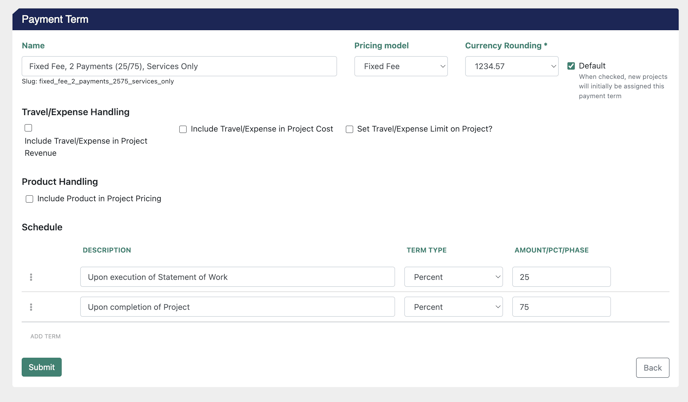Payment Terms for Professional Services
Using Payment Terms to dictate Professional Services Pricing.
Payment terms are a powerful feature that all you to control key elements of your Professional Services Pricing.
Managing Available Payment Terms
Managing the List of Terms
You can use Payment Terms for Professional Services under Settings > Financial > Payment Terms.
On this page, you can see a list of the payment terms in your account.

The different columns indicate information about the Payment Term. You can edit a term by clicking the term in the list or create a new one using the + Add Payment Term button at the bottom of the list.
You can also drag and drop the terms into the specific sequence you would have presented on a project.
Managing or Creating a Term
Overall Settings
Inside a term, you can modify a few different attributes using the overview area.

-
Name: This is the name the term will have in the platform.
-
Slug: This is automatically generated by the platform based on the name of the term and can be used to inject particular language for a specific term in a document template
-
Pricing Model: This is a logical test for use in documents to determine if a Payment Term represents a Fixed Fee, Time & Materials, or Other category of term. These distinctions can be used to conditionally include language in a document based on the selected model.
-
Currency Rounding: You can round the project's price to the designated number of decimal places. This rounding occurs at the smallest level of effort (Service and Subservice) and adds up to ensure figures are added appropriately. Note that this attribute also affects Managed Services.
- Default: This lets you designate a specific term as the "default" term for use in projects in your account. All projects will be created with this term selected
- Travel and Expense & Product Handling
- Include Travel/Expense in Project Revenue: This controls whether the pricing for any Travel and Expense items is included in the Project's Revenue.
- Include Travel/Expense in Project Cost: This controls whether the pricing for any Travel and Expense items is included in the Project's Cost.
- Set Travel/Expense Limit on Project?: This controls whether you want to set an informational T&E Limit on the project.
- Include Product in Project Pricing: This controls whether you want to include the revenue and cost of any included Product in the pricing of your project.
Payment Term Schedules
The Schedule function allows you to create a payment schedule based on the dynamic values of project elements. The primary use case for the schedule is to build a payment schedule in a document.
-
Description: This allows you to give each item a name
-
Term Type: This allows you to dictate either a percentage-based or milestone-based amount to calculate.
-
AMOUNT/PCT/PHASE: This is where you designate the appropriate item that will be used to calculate a payment schedule.
Percentage-Based Schedules
Percentage-Based Schedules are calculated by the percentages you put in the third column. For example, for a project with a price of $1000.00, this payment schedule setup...
-
Payment 1, Percentage, 25%
-
Payment 2, Percentage, 75%
Would yield:
-
Payment 1: $250.00
-
Payment 2: $750.00
Milestone-Based Schedules
Milestone-Based Schedules are calculated based on the phase-alignment of services in the specific project. For example, for a project with a price of $1000, with...
-
Phase 1: 12.5% of the revenue in a Prepare Phase
-
Phase 2: 12.5% of the revenue in a Plan Phase
-
Phase 3: 25% of the revenue in a Design Phase
-
Phase 4: 50% of the revenue in an Implement Phase
With the following payment term Schedule:
-
Payment 1, Milestone, Plan
-
Payment 2, Milestone, Design
-
Payment 3, Milestone, Implement
Would yield:
-
Payment 1: $250
-
Payment 2: $250
-
Payment 3: $500
Let's pause to notice what happened here: The platform identified that the first schedule item happened at Phase 2, so it automatically added up everything between the previous term (it's the first term, so nothing prior in this case) and the current term and used that as the basis of revenue.
-
Payment 1: Phase 1 + 2 Revenue
-
Payment 2: Phase 3 Revenue
-
Payment 3: Phase 4 Revenue
Balance Due
Any amount left in either a percentage or milestone-based schedule will result in an automatically generated "Balance Due" item that will display the difference between the summed result of the output payments and the project's total price.
In a Project
In a project, you can select the Payment Term you would like to use for that project under Pricing > PS Pricing. YOu can also select this on the Project Overview screen.
Using Payment Terms in Documents
Payment Terms are a powerful feature. Be sure to check out our Common Merge Field templates for examples of how to use them in projects, and learn about how to read and use the Merge Data to create your own Payment Term options.
